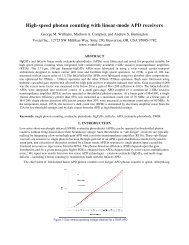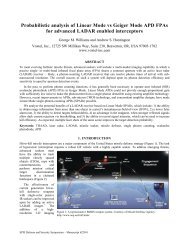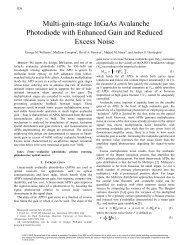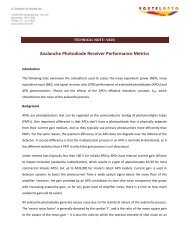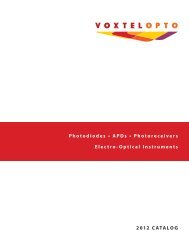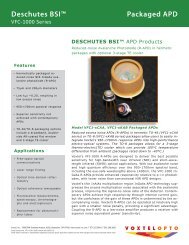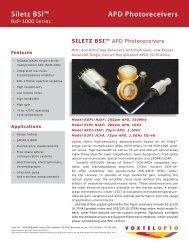Characterization of HgCdTe MWIR Back-Illuminated II-VI-07 ... - Voxtel
Characterization of HgCdTe MWIR Back-Illuminated II-VI-07 ... - Voxtel
Characterization of HgCdTe MWIR Back-Illuminated II-VI-07 ... - Voxtel
- No tags were found...
Create successful ePaper yourself
Turn your PDF publications into a flip-book with our unique Google optimized e-Paper software.
The breakdown voltage increases with increasing temperature in a given diode. This can be seen in<br />
the data in the upper plot in Fig. 11, where the breakdown voltage increases from -10.4 V at 80 K to -11.7 V<br />
at 160 K.<br />
The breakdown voltage increases with energy band gap for devices <strong>of</strong> comparable design and<br />
processing. This can be seen in Fig. 11. The lower plot shows a breakdown voltage <strong>of</strong> -12.8 V for a cut<strong>of</strong>f<br />
wavelength <strong>of</strong> 3.54 µm at 160 K, whereas the upper plot shows a breakdown voltage <strong>of</strong> -11.7 at 160 K for a<br />
cut<strong>of</strong>f <strong>of</strong> 4.05 µm at 160 K.<br />
The breakdown voltage may vary somewhat from element to element within an array or within a film,<br />
but <strong>of</strong>ten the breakdown voltages tend to be the same within an array or within a film. For example, the lower<br />
plot in Fig. 11 shows I(V) data for a set <strong>of</strong> variable-area diodes, all with the same breakdown voltage.<br />
After experiencing breakdown, some diodes recover immediately, while some diodes are permanently<br />
shorted.<br />
Based on these observations, we believe the abrupt breakdown is not a fundamental limit to the<br />
largest bias voltage that can be applied. We believe that this breakdown can be pushed to larger voltages<br />
through modifications to device design and processing.<br />
SUMMARY AND CONCLUSIONS<br />
This paper has presented new characterization data for <strong>MWIR</strong> back-illuminated planar <strong>HgCdTe</strong> e-<br />
APDs.<br />
Gain versus voltage data for a new film with a longer cut<strong>of</strong>f wavelength, 4.29 µm at 160 K, support<br />
the exponential increase <strong>of</strong> gain with cut<strong>of</strong>f wavelength for the same bias voltage that we reported previously<br />
for two films with shorter cut<strong>of</strong>f wavelengths <strong>of</strong> 3.54 and 4.06 µm at 160 K. The gain versus voltage data at<br />
160 K for all three films agree reasonably well with the Beck empirical model.<br />
Dark current versus voltage data at 80 K for F/5 are dominated by the gain-multiplied photocurrent<br />
due to background radiation, while at FOV=0 the dark current increases more rapidly than the gain,<br />
suggesting a tunneling-related leakage current. The lowest values <strong>of</strong> gain-normalized dark current density at<br />
-15-




